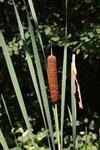| Family | Scientific Name | Common Name | Habitat | Distribution | Image |
|---|---|---|---|---|---|
| Typhaceae | Typha angustifolia | Narrowleaf Cattail | Brackish to fresh waters of marshes and swamps, usually tidal, and also inland in non-tidal wetlands (where probably only introduced). | NS west to ND, south to SC, FL (?), LA, and TX (?); Eurasia. Stuckey & Salamon (1987) considered T. angustifolia an invasive alien in North America, but later studies suggest that it was native at least in coastal areas of ne. and Mid-Atlantic North America, and has expanded its range westward in recent decades (Shih & Finkelstein 2008). Ciotir et al. (2013) and Ciotir & Freeland (2016) suggested that T. angustifolia in North America is closely related to T. angustifolia in Europe, and its occurrence in North America may be a recent dispersal. For now, we consider inland populations as non-native, and populations in tidal settings along the Atlantic Coast as of uncertain nativity. |  |
| Typhaceae | Typha angustifolia × domingensis | Brackish to nearly fresh waters of marshes and swamps, usually tidal. | |||
| Typhaceae | Typha angustifolia × latifolia | Hybrid Cattail | Fresh to brackish waters of lakes, ponds, and rivers. |  | |
| Typhaceae | Typha domingensis | Southern Cattail | Brackish to nearly fresh waters of marshes and swamps, usually tidal. | DE south to s. FL, west to TX; north inland to NE and UT; and south into tropical America; Eurasia; Africa; Oceania. |  |
| Typhaceae | Typha domingensis × latifolia | Fresh to brackish waters of lakes, ponds, and rivers. | |||
| Typhaceae | Typha latifolia | Common Cattail | Fresh waters of ponds, lakes, ditches, marshes, including in tidal freshwater marshes. | NL (Newfoundland) west to AK, south to FL, TX, CA, and Mexico; Central America; South America; Eurasia. |  |
Cite as...